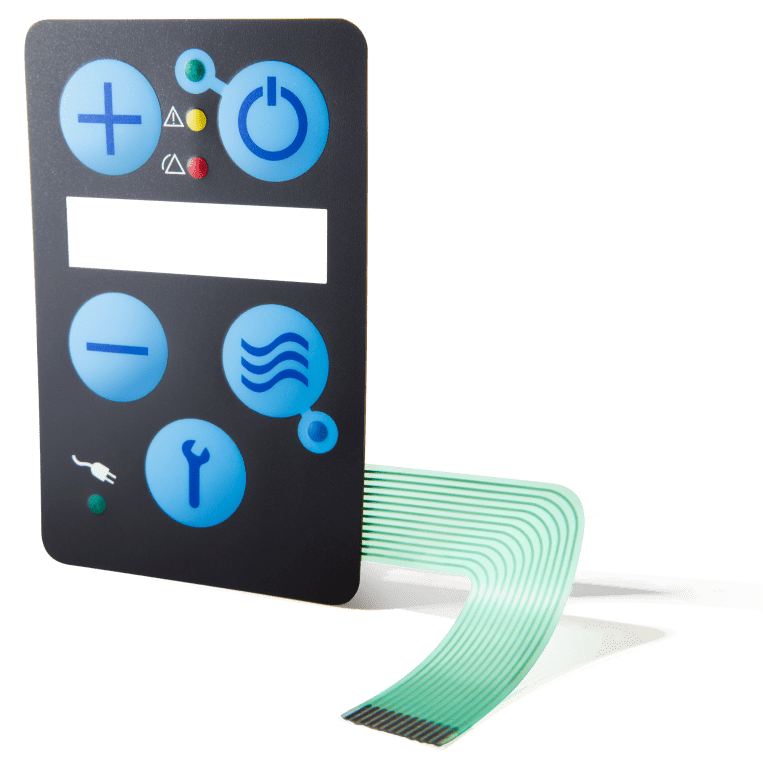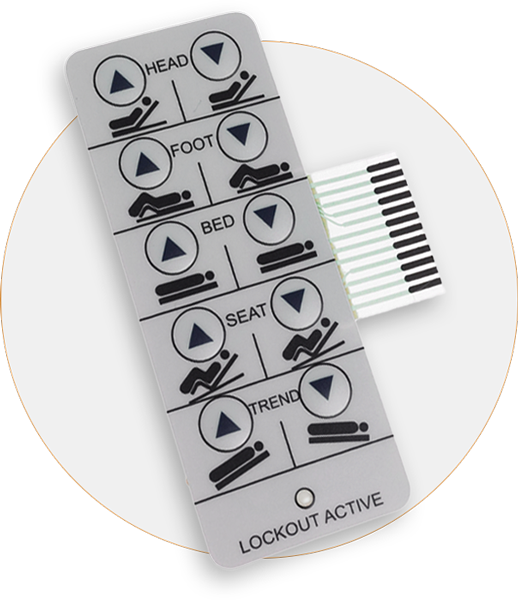Learn About the Environmental Benefits of Using Membrane Switches in Electronic Devices
Learn About the Environmental Benefits of Using Membrane Switches in Electronic Devices
Blog Article
The Ultimate Resource on Membrane Changes: Layout, Capability, and Applications
Membrane layer switches act as an intriguing intersection of style and performance, playing a crucial role in contemporary interface across different sectors. This resource unpacks the important elements that add to their performance, consisting of visuals overlays and circuit traces, while likewise elucidating the mechanisms behind their pressure activation. As we check out the varied applications of membrane switches, it comes to be obvious that their versatility and longevity are critical in atmospheres varying from healthcare to consumer electronic devices. The subtleties of their style and operational concepts might disclose even deeper understandings worth considering.

Comprehending Membrane Layer Buttons
Membrane switches are a kind of interface modern technology commonly made use of in various digital devices, defined by their thin, adaptable layout and capability. These switches include numerous layers that consist of graphic overlays, adhesive layers, and wiring, making it possible for a reliable and portable user interface for individuals. They can be discovered in appliances, medical devices, and commercial control panels, offering a trusted approach for user interaction.
One of the key benefits of membrane buttons is their capability to stand up to pollutants such as dirt and moisture, making them suitable for settings where longevity is crucial. Their inconspicuous style enables smooth integration into various applications, while the personalized visuals overlays improve customer experience by offering clear visual feedback. Additionally, membrane buttons can suit a variety of innovations, such as responsive responses and backlighting, further boosting their usability.
The manufacturing procedure for membrane changes typically involves screen die-cutting, printing, and lamination methods, ensuring precision and consistency in manufacturing. On the whole, membrane layer changes stand for a versatile and effective remedy for modern digital gadgets, combining capability with visual charm in user interface layout.
Key Components and Layout Elements
A selection of vital components and layout aspects integrated to create a reliable membrane layer button. At the core, the visuals overlay offers both aesthetic and functional objectives, using an user-friendly user interface while safeguarding interior parts from environmental variables. The option of products, generally polyester or polycarbonate, affects sturdiness and tactile responses.
Below the overlay, the adhesive layer ensures the button adheres firmly to the substratum, which can be steel, plastic, or glass. The spacer layer is critical, as it preserves the required space between the overlay and the circuit layers, enabling efficient actuation. Membrane Switches. Circuit traces, normally made from conductive ink or adhesive, are printed on a flexible substrate, enabling electrical signals to be transferred when stress is applied
Design factors to consider also consist of the arrangement of tactile domes or embossing that supply physical comments to the user, improving the overall experience. Additionally, the layout and spacing of the buttons need to be enhanced for simplicity of use, ensuring that customers can browse the user interface intuitively. In general, these elements and style aspects function synergistically to develop a reputable, useful membrane button tailored to details applications.
Functionality and Operation System
At the heart of effective functionality for membrane changes lies their operational device, which promotes individual interaction via a straightforward yet reliable style. These switches operate the concept of stress activation, where an individual uses force to a designated area of the switch (Membrane Switches). This activity compresses the layers of the button, finishing an electric circuit that sends out a signal to the connected device
The construction commonly consists of a leading graphic layer, a sticky spacer layer, and a bottom circuit layer, which collectively form a robust user interface. When stress is applied, the top layer falls down versus the lower circuit layer, enabling conductive traces to connect. This design not just allows clear responsive responses but also ensures toughness and integrity, as the buttons are usually immune to dirt and moisture.
Moreover, the versatility of membrane switches over enables for integration with different innovations, including LED indications and microcontrollers, improving their functionality. By giving a structured interface that minimizes mechanical wear, membrane layer switches remain a popular choice in applications varying from consumer electronics to commercial equipment, making sure optimal performance and user satisfaction throughout varied look at here now atmospheres.
Kinds Of Membrane Layer Buttons

One more substantial classification is illuminated membrane buttons, which incorporate backlighting to improve exposure in low-light problems. These buttons are often made use of in control panels and control panels where clear presence is crucial.
Additionally, there are custom-made membrane layer switches made to fulfill certain dimensional, visual, and useful requirements. These customizations can include one-of-a-kind shapes, shades, and formats, permitting for smooth combination right into different gadgets.

Applications Across Numerous Industries
How do membrane layer switches improve functionality across varied markets? In the clinical industry, membrane layer buttons play a vital role in tools such as diagnostic devices and individual tracking systems, where integrity and ease of cleansing are paramount.
In the automotive sector, membrane switches are generally utilized in dashboards and control board, offering user-friendly controls that boost chauffeur safety and security and comfort. The consumer electronic devices market additionally this contact form benefits from their adjustable and light-weight features, allowing smooth layouts for smartphones and home appliances.
Additionally, membrane layer buttons locate applications in industrial automation, where they add to effective equipment procedure and surveillance systems. Their resistance to dust and moisture guarantees performance popular conditions (Membrane Switches). In addition, the food and drink sector employs membrane buttons for tools control, where health and sturdiness are important
Verdict
In final thought, membrane switches over represent an important advancement in individual interface technology, identified by their special style and performance. The versatility of membrane layer changes facilitates their application throughout diverse industries, from clinical devices to customer electronic devices.
Membrane switches over offer as an intriguing junction of style and performance, playing a pivotal function in modern individual interfaces across various markets.Membrane buttons are a kind of customer interface technology extensively utilized in numerous electronic devices, defined by their slim, adaptable layout and functionality.At the heart of efficient functionality for membrane changes lies their functional mechanism, which assists in customer interaction through a basic yet efficient style. These buttons operate on the concept of pressure activation, where a customer applies force to a marked location of the button.In final thought, membrane layer switches over represent an essential technology in user interface innovation, identified by their unique style and capability.
Report this page